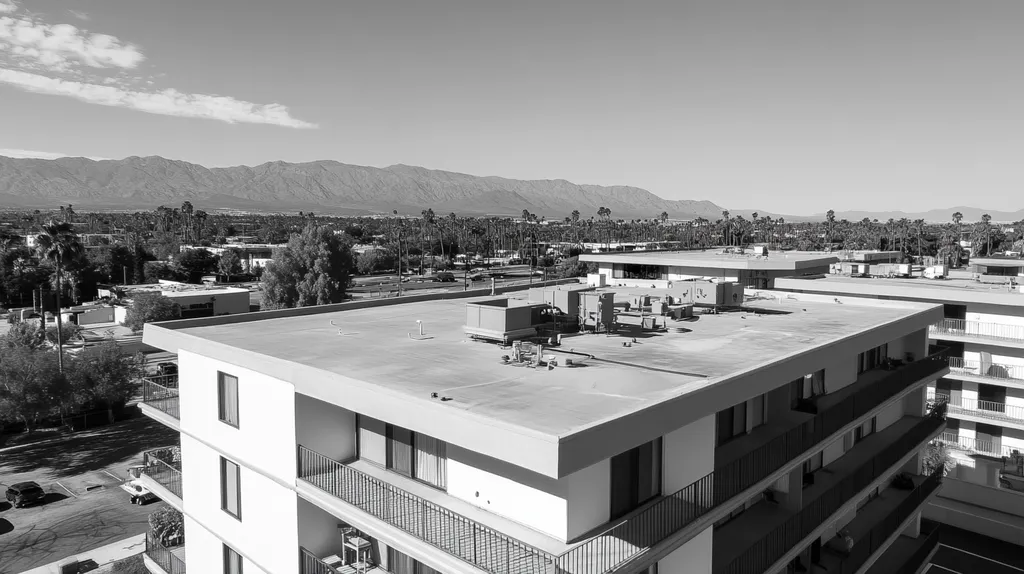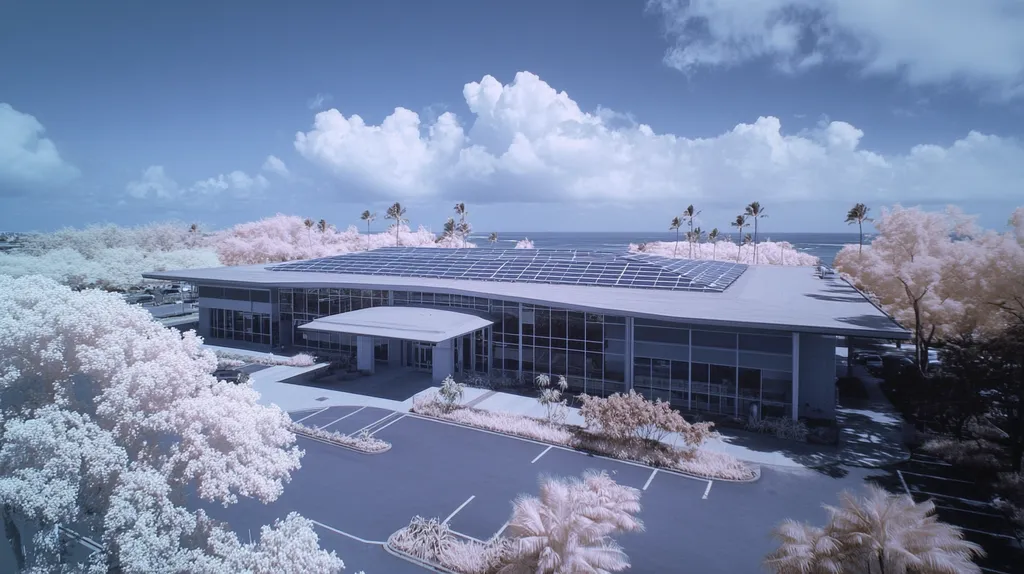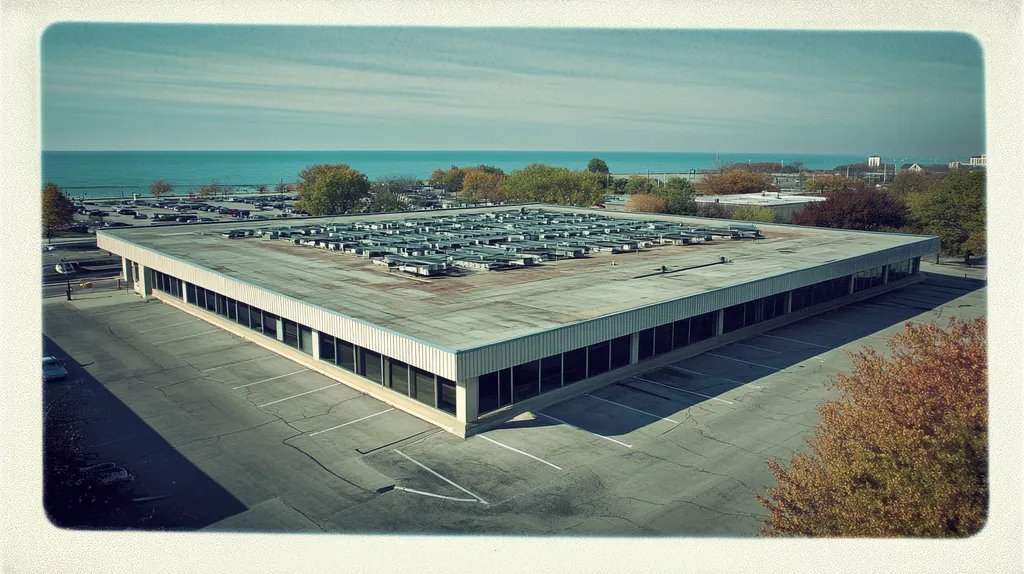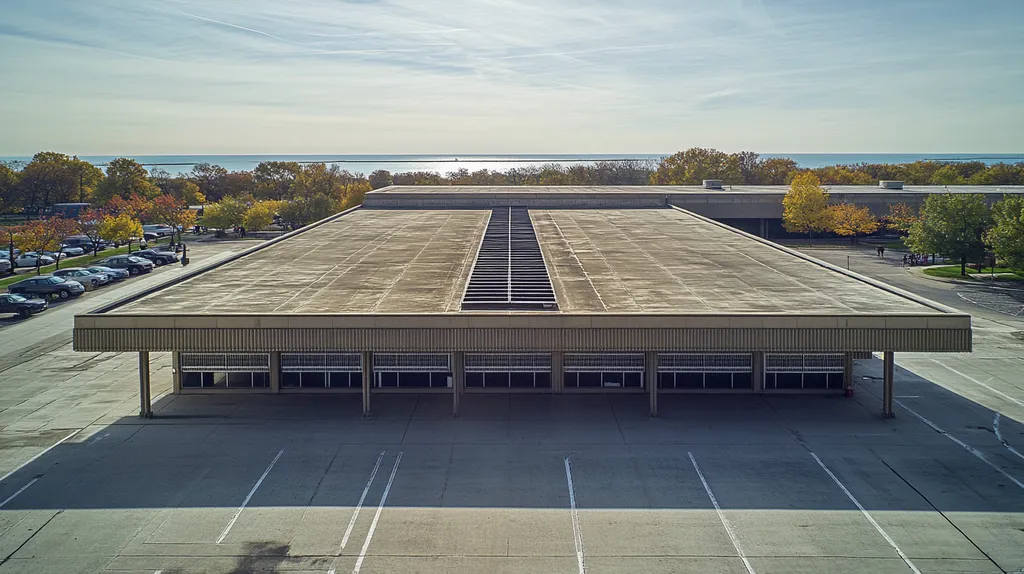In the high-stakes world of industrial roofing, myths about sustainable coatings are costing facility owners millions in premature roof failures and skyrocketing energy bills. Studies show that 70% of industrial roofs underperform due to misinformation about coating choices.
From silicone’s supposed waterproof superiority to questionable claims about coating longevity, these misconceptions are more than just costly – they’re threatening the very sustainability initiatives they claim to support.
It’s time to separate fact from fiction and examine the real science behind industrial roof coatings, their environmental impact, and their role in modern facility management.
SECTION 1: COMMON MISCONCEPTIONS
When it comes to industrial roofs, property owners and facility managers often find themselves navigating through a maze of misconceptions about roof coatings. These misunderstandings can lead to costly decisions over time, as evidenced by research showing that nearly 30% of industrial roofs fail prematurely due to poor coating choices. Clearing up these myths can empower decision-makers to make choices that not only ensure durability but also promote sustainability. In this section, we’ll tackle three common misconceptions that may cloud judgment and obstruct effective roofing strategies.
Silicone Coatings are Completely Waterproof
A persistent myth surrounding silicone coatings is their supposed immunity to water, which can mislead property owners into a false sense of security. While silicone does excel at repelling water, it isn’t completely watertight, especially when faced with situations like pooling water or ponding, which can compromise the coating over time and lead to leaks.
This misconception arises from silicone’s impressive ability to bead water off its surface, but this feature can create an illusion of infallibility. To avoid issues, it’s vital to ensure that the coating is installed correctly and that any underlying roof conditions are taken into account.
Routine maintenance is key for facility managers to keep roofs performing at their best. Regular inspections can highlight potential vulnerabilities before they develop into larger, more expensive problems, ultimately safeguarding the building’s integrity and extending the life of the coating.
Furthermore, pairing silicone coatings with efficient drainage systems can dramatically enhance roof performance. This approach not only fortifies the coating’s protective qualities but also contributes to a more sustainable roofing solution overall.
Silicone Coatings are Always Better than Acrylic
The notion that silicone coatings are universally superior to acrylic options is a common trap for decision-makers. While silicone coatings may shine in certain scenarios, acrylic coatings offer distinct advantages that could make them a smarter choice depending on specific conditions. For instance, acrylic coatings are known for their reflective properties, which can significantly reduce energy costs by enhancing energy efficiency.
Additionally, acrylic coatings dry quickly and can often be applied in cooler temperatures. This flexibility is particularly beneficial for facilities that experience fluctuating temperatures, allowing for faster installations and minimal downtime.
Another important factor is compatibility with existing roofing materials. While silicone might struggle to adhere to some substrates, acrylic coatings generally create a stronger bond in these cases. A careful evaluation of each project’s unique conditions is essential for choosing the right coating and maximizing its potential.
Ultimately, the choice between silicone and acrylic should be based on the specifics of the project rather than blanket assumptions. Thoughtful consideration of the roofing system and local climate will yield the best performance outcomes.
Silicone Coatings are 100% Solids-Based
Many people are surprised to learn that not all silicone coatings are 100% solids-based, leading to misconceptions about their makeup and effectiveness. Although there are silicone products that fit this high-performance category, many contain solvents that can influence their application and overall performance. Solvent-based formulations can evaporate during curing, which often results in reduced film thickness and can affect durability.
Understanding the diversity in coating formulations is crucial for making informed decisions. 100% solids silicone coatings typically provide greater surface build and perform better in wet conditions, but they may also involve higher costs and specific application requirements.
On the other hand, lower-solids formulations can effectively meet particular needs, such as cost-reduction goals. It’s vital for property managers to be aware of the various options available to ensure they select the most appropriate coating for their industrial roofs.
In summary, debunking these common misconceptions equips property owners and managers to make smarter, more informed choices about roof coatings. A comprehensive understanding of the unique traits of both silicone and acrylic coatings promotes a strategic and sustainable approach to industrial roofing.
SECTION 2: PRACTICAL IMPLICATIONS
The transition to sustainable roof coatings isn’t just a trend; it’s a game changer for the efficiency and lifespan of industrial buildings. Making the wrong coating choice can lead to soaring energy costs and a significantly decreased roof lifespan. Many property owners often underestimate the profound impact that a roof coating can have on energy consumption, HVAC effectiveness, and the indoor environment.
Impact on Energy Efficiency and HVAC
For industrial facilities, rising energy costs are a pressing concern linked to inefficient roofing systems. Sustainable coatings are designed to reflect sunlight, which helps lower roof surface temperatures. This reflective property reduces the workload on HVAC systems, which in turn lowers energy bills.
In fact, facilities that have adopted reflective roof coatings have reported energy use reductions of up to 30% during peak cooling months. This newfound efficiency not only trims costs but also extends the life of HVAC systems, allowing them to maintain comfortable temperatures without excessive strain.
Choosing energy-efficient roofing is not only a nod to sustainability; it also positions facilities managers to reap potential tax incentives, enhancing the financial viability of these investments.
However, it’s crucial to recognize that not every coating offers the same performance. Property owners should work with knowledgeable professionals to ensure they select coatings that adhere to energy standards while also showcasing durability.
Effects on Roof Lifespan and Maintenance
For industrial properties, a roof’s longevity is critical, and sustainable coatings can significantly bolster this durability. These coatings provide a robust defense against UV rays, severe weather, and other environmental challenges that degrade roofing materials over time.
Research indicates that roofs that benefit from high-quality sustainable coatings can last up to 15 years longer than those without them. This durability leads to decreased maintenance costs and minimizes interruptions to business operations, allowing companies to focus on what they do best.
On top of that, many sustainable coatings can be applied as a straightforward maintenance solution, eliminating the need for costly and disruptive roof replacements. This means property owners can efficiently extend their roof’s life without the usual hefty investment associated with full replacements.
Regular assessments of the roofing condition and maintaining the coatings are essential to maximizing effectiveness. Proactive maintenance can catch minor issues before they escalate, ensuring the roof continues to perform optimally.
Influence on Indoor Comfort and Temperature
Indoor comfort plays a pivotal role in employee productivity and happiness within industrial buildings. Sustainable roof coatings help maintain comfortable indoor temperatures, creating a more pleasant workspace. By minimizing heat gain during the summer months, these coatings help to stabilize indoor conditions.
A cooler roof means cooler interiors, positively influencing both workforce morale and the longevity of equipment. High indoor temperatures can lead to diminished employee performance, which can ultimately result in lower productivity levels.
Moreover, when indoor temperatures are controlled effectively, the HVAC system can run more efficiently, leading to additional cost savings. Property owners are increasingly realizing that investing in sustainable roof coatings serves a dual purpose: boosting comfort while simultaneously reducing operational expenses.
Ultimately, creating a comfortable work environment contributes to lower turnover rates and increased job satisfaction, providing industrial facilities with a significant strategic edge.
SECTION 3: COST OF MISINFORMATION
The stakes are high for owners of industrial buildings when it comes to making choices about their roofs. Falling for misleading information regarding sustainable roof coatings can lead to costly mistakes, potentially costing tens of thousands of dollars. Understanding these risks is essential for making savvy choices, as misinformation can spell disaster in terms of maintenance needs and the lifespan of the roof.
Financial Consequences of Incorrect Choices
Choosing an inadequate roof coating can quickly turn into an expensive misstep. The initial savings from opting for a cheaper coating might be enticing, but these savings can evaporate fast when maintenance issues arise. The repercussions often include higher costs for routine inspections and repairs due to inadequate performance.
Moreover, roofing problems don’t just sit idle; they can disrupt business operations. Leaks or poor insulation can snowball into lost productivity, ultimately hurting the bottom line. Property owners need to consider the hidden costs of flimsy solutions compared to the potential savings of investing in quality coatings.
Research indicates that facilities investing in high-quality coatings often enjoy a lower total cost of ownership throughout the roof’s lifespan. Each coating choice should therefore factor in both immediate costs and long-term financial health. A smartly selected coating not only prevents financial pitfalls but enhances energy efficiency, further boosting operational savings.
Increased Maintenance and Repair Costs
Regular upkeep on an industrial roof is essential for its longevity, but many property owners are misled by glossy marketing claims, leading to higher repair bills. Instead of securing a reliable waterproofing solution, they might find themselves with a coating that fails prematurely, necessitating pricey touch-ups.
Statistics reveal that roof maintenance can represent up to 20% of total roofing expenditures. A poorly chosen coating could significantly increase this percentage due to accelerated wear and tear. Frequent re-coating or repairs can quickly drain budgets, diverting funds from other critical aspects of the business.
Frequent maintenance not only incurs repair costs but also heightens labor expenses. Continually hiring skilled contractors pushes expenses upward, and lost labor hours can create even more complications for site operations. To escape this cycle, property owners must pursue reliable information about coatings to avoid unnecessary expenditures and build a sustainable long-term roof maintenance strategy.
Potential for Premature Roof Replacement
One of the stark realities of poor coating decisions is the likelihood of needing a roof replacement much sooner than intended. When coatings fail, it’s not just a quick fix; the entire roof may need to be replaced, causing both operational and financial strain on the business.
Replacement costs for roofs can vary widely, often reaching into the hundreds of thousands for industrial facilities. Misinformation that leads to inadequate coating performance can mean that property owners are faced with the financial burden of replacing roofs within a fraction of their expected lifespan. This costly scenario is not only avoidable but also preventable with informed choices.
Furthermore, the environmental implications of premature roof replacements are significant, contributing to landfill waste and enlarging the facility’s carbon footprint. Making educated roofing decisions is crucial for both fiscal responsibility and environmental mindfulness. A proactive approach to sustainable coating selection can prolong the roof’s functional life while reducing unnecessary costs.
SECTION 4: REALITY CHECK
When it comes to sustainable roofing solutions, industrial property owners are often walking a tightrope. With a staggering 70% of industrial roofs failing due to poor material choices, this isn’t just a minor inconvenience—it can lead to expensive repairs and interrupt daily operations. Grasping the true performance of silicone coatings compared to other options is crucial for decision-makers looking to invest wisely in the longevity and efficiency of their roofs.
Actual Performance of Silicone Coatings
Silicone roof coatings are frequently touted for their durability and reflectivity, but that promise doesn’t always align with real-world performance. While they excel in waterproofing, silicone coatings can encounter challenges during extreme weather. For example, they may become dangerously slippery when wet, posing risks for maintenance crews.
In addition, silicone’s adhesion quality can vary based on the substrate, leading to premature failures if installation isn’t executed properly. The impressive lifespan often advertised by manufacturers may not be achievable in all climates, especially areas experiencing significant temperature changes. These discrepancies could lead to unexpected costs and downtime for businesses.
Another aspect to keep in mind is the potential for algae and mildew growth. This not only affects the aesthetic appeal of the roof but can also impede the coating’s effectiveness. To maintain performance, effective cleaning and maintenance are essential, yet these costs are often overlooked in initial estimates.
By understanding these particularities, facility managers can make informed choices rather than simply relying on promotional claims. Knowing the real performance expectations under specific conditions is critical for aligning choices with sustainability goals.
Comparison with Other Roof Coating Types
When evaluating roof coating options, comparing silicone to alternatives like acrylic and polyurethane is vital. Acrylic coatings, for instance, shine with excellent UV resistance and can be applied at lower temperatures, making them adaptable to various climates. Their quick drying time minimizes downtime during installation—always a plus for busy facilities.
On the other hand, polyurethane coatings stand out for their durability and flexibility, withstanding foot traffic and mechanical wear better than silicone. However, they typically come at a higher price and may necessitate specialized equipment for application.
Each coating type has its benefits and drawbacks, and the best choice often hinges on situational factors such as climate, the building’s function, and expected roof lifespan. A careful evaluation using these criteria is essential for achieving optimal roof performance.
By exploring these alternatives side-by-side, property owners can gain a clearer understanding of the trade-offs involved. This analytical approach empowers facility managers to choose a coating system that strikes a balance between performance, sustainability, and safety.
Real-World Applications and Success Stories
There are numerous examples of industrial facilities that have successfully implemented alternative coatings, showcasing improved longevity and efficiency. Take, for instance, a manufacturing plant in Arizona that switched from silicone to a high-performance acrylic coating, resulting in a 30% reduction in energy costs thanks to its enhanced reflectivity.
Another success story comes from a large distribution center in the Midwest that transitioned to polyurethane, reporting fewer maintenance interruptions and significantly better water resistance. This shift extended the roof’s lifespan far beyond the industry norm.
Such real-world outcomes highlight that the ideal coating choice often depends on a facility’s unique needs, climate factors, and desired longevity for the roof. An informed decision can yield impressive returns on investment and contribute to overall sustainability.
Using real-world data to guide future coating choices reinforces the importance of basing decisions on facts rather than just perceptions. By learning from the successes and challenges encountered by others in the industry, property owners can make smarter, more sustainable roofing decisions.
SECTION 5: EVIDENCE-BASED ALTERNATIVES
The urgency for adopting sustainable roofing practices is evident. Industrial buildings consume a staggering amount of energy, with roof coatings playing a critical role in energy regulation. Traditional coatings can trap heat, leading to exorbitant cooling costs. In contrast, advanced alternatives like silicone coatings offer a pathway to enhanced efficiency, environmental compliance, and significant long-term savings. This section explores the solid evidence backing these innovative choices.
Sustainable Benefits of Silicone Coatings
Silicone roof coatings bring a wealth of sustainable advantages that shouldn’t be overlooked. Unlike traditional coatings, silicone materials boast excellent reflectivity, drastically reducing heat absorption. This means lower cooling costs and less urban heat, creating a more comfortable environment.
One of the standout features of silicone coatings is their impressive durability—they can last over 20 years with minimal maintenance. This durability translates to fewer resources spent on repairs and replacements, making them a wise choice from an environmental perspective. Plus, silicone coatings are often water-based, minimizing hazardous material usage critical for sustainable roofing.
By opting for silicone coatings, property owners can not only enhance their roof’s lifespan but also significantly lower their environmental impact. This commitment to sustainability elevates building performance while aligning with corporate social responsibility goals.
With the growing appetite for green building certifications, investing in silicone roof coatings is on-trend, catering to the market’s preference for sustainable construction practices. Making this choice gets property owners ahead in a world increasingly focused on environmental responsibility.
Environmental Impact and Compliance
Switching to silicone coatings offers environmental benefits that go beyond energy savings; they can also help businesses comply with regulations. Governments worldwide are tightening environmental policies, and those still using traditional coatings may face increased scrutiny and potential fines.
Thanks to their low volatile organic compound (VOC) content, silicone coatings typically align with standards like those set by the Environmental Protection Agency (EPA). This compliance is key for property owners looking to adhere to environmental regulations and reduce liabilities.
Additionally, adopting silicone coatings may open the door to rebates and incentives from local and federal programs designed to promote sustainable building practices. By leveraging silicone technologies, companies can cover installation costs while fulfilling compliance obligations.
Using silicone coatings can substantially reduce a company’s environmental footprint. As property managers face increased public scrutiny over their environmental actions, selecting compliant roofing materials becomes crucial for maintaining a positive operational reputation.
Long-Term Cost Savings and ROI
Though investing in silicone roof coatings may require higher initial spending, the long-term return on investment (ROI) can be impressive. Property owners enjoy reduced energy costs from enhanced thermal performance, allowing for a quicker recovery of their investment.
Moreover, the durable nature of silicone coatings means less frequent maintenance and fewer repairs. Research shows that facilities can see maintenance costs drop by as much as 30% after transitioning to silicone. These savings enable property owners to redirect resources toward other critical business needs.
Investing in sustainable roofing solutions can also enhance property value. Buildings showcasing eco-friendly roofing are often more appealing in the market, potentially leading to higher lease rates and attracting environmentally conscious tenants.
In summary, the financial advantages of silicone coatings reach beyond immediate savings. A comprehensive cost analysis reveals that property owners can achieve significant ROI, making silicone coatings an attractive choice for the future of industrial roofing.
SECTION 6: TEST AND VERIFY
When it comes to industrial roofing, applying sustainable coatings is only the first step in a multifaceted process. Alarmingly, a staggering 70% of roofing problems stem from poor surface preparation, leading to costly repairs that could have been avoided. To ensure the longevity and effectiveness of roof coatings, property owners and facilities managers must prioritize thorough testing and verification. This section dives into the essentials of surface preparation, the pivotal role of monitoring systems, and important warranty considerations that impact roof care.
Importance of Proper Surface Preparation
Getting the surface ready is crucial for any roof coating project to succeed. Without careful cleaning and priming, coatings may not stick well, paving the way for rapid deterioration. Unfortunately, many facilities assume that a quick rinse is enough, leading to disastrous results.
This common oversight can result in coatings failing prematurely, resulting in expensive repairs or total replacements. It’s imperative to thoroughly assess the existing roof condition, ensuring a clean slate free from dirt, grease, and debris. Checking for any hidden damage before applying coatings sets the stage for solid protection.
Moreover, manufacturers often outline specific surface preparation protocols that directly affect warranty coverage. Not adhering to these guidelines can void warranties, leaving property owners with unexpected repair bills.
In closing, investing time and resources in surface preparation is essential for maximizing the lifespan and efficacy of sustainable roof coatings.
Role of Intelligent Rooftop Monitoring Systems
Intelligent rooftop monitoring systems are game-changers for maintaining the integrity of industrial roof coatings. These systems deliver real-time data on critical factors like temperature, humidity, and substrate conditions, empowering facility managers to make informed maintenance decisions.
By detecting early signs of coating failure, monitoring systems enable timely interventions that extend the life of the roofing solution. For instance, if excessive moisture is detected, appropriate action can be taken to address potential problems before they escalate into major issues.
Additionally, integrating these monitoring technologies can significantly boost energy efficiency. The data collected can inform adjustments that lead to reduced heat absorption, ultimately lowering energy costs. This blend of technology and sustainability makes monitoring systems a must-have for modern roofing strategies.
Ultimately, these intelligent systems not only protect financial investments but also support long-term sustainability goals.
Warranty and Maintenance Considerations
Understanding warranty terms and maintenance requirements is paramount in sustainable roofing. Many property owners mistakenly believe that a warranty guarantees full performance, but the fine print typically outlines specific maintenance responsibilities. Failure to comply can void warranty coverage, leaving property owners to foot the bill for repairs.
Routine inspections and maintenance play a vital role in sustaining coatings, as they can degrade over time due to environmental stressors. Establishing a regular maintenance schedule can substantially reduce the risk of serious issues arising down the line.
Additionally, property owners should take the time to fully grasp warranty terms before moving ahead with a coating application. Collaborating with reputable manufacturers can clarify expectations and bolster confidence in the chosen products.
To sum up, adopting a proactive approach to warranty and maintenance can protect investments while ensuring the lasting effectiveness of roof coatings.
The Bottom Line
With 70% of industrial roofs underperforming due to coating misinformation, facility managers can no longer afford to ignore the realities of sustainable roofing choices.
The evidence is clear: proper coating selection, installation, and maintenance can extend roof life by up to 15 years while reducing energy costs by 30% or more.
Success requires moving past outdated myths about silicone’s capabilities and embracing evidence-based solutions that balance performance, sustainability, and cost-effectiveness.
For industrial property owners, the path forward demands rigorous surface preparation, intelligent monitoring systems, and proactive maintenance – core practices that transform roofing from a liability into a strategic asset.
The future of industrial roofing isn’t just about protecting buildings – it’s about protecting bottom lines and our planet.
FREQUENTLY ASKED QUESTIONS
Q. What are common misconceptions about commercial roof coatings?
A. Many property owners mistakenly believe that silicone coatings are completely waterproof, which is not true. While they repel water, they can fail if pooling occurs. Regular maintenance and correct installation are key to preventing leaks and ensuring coating performance.
Q. How do industrial roofs affect energy efficiency?
A. Industrial roofs play a significant role in energy efficiency by impacting HVAC performance. Sustainable roof coatings can reflect sunlight, reducing surface temperatures and lowering energy bills by alleviating stress on cooling systems, thus enhancing overall building efficiency.
Q. What are the financial consequences of choosing the wrong coating?
A. Opting for an inadequate roof coating can lead to hefty repair bills and increased maintenance needs. Poor choices can also disrupt business operations, incurring hidden costs that exceed initial savings, making quality coatings a worthwhile investment for long-term financial health.
Q. How do the performances of silicone coatings compare to others?
A. While silicone coatings are known for their durability, they may not always outperform alternatives like acrylic or polyurethane. Each coating has unique attributes, making it essential for property owners to evaluate their specific needs and climate conditions when selecting a solution.
Q. What are the environmental benefits of silicone coatings?
A. Silicone coatings reduce heat absorption and energy consumption, leading to lower cooling costs. They’re often made with low volatile organic compounds, contributing to better indoor air quality and compliance with environmental regulations, enhancing overall sustainability efforts for facilities.
Q. How important is surface preparation for industrial roof coatings?
A. Proper surface preparation is vital for ensuring coatings adhere effectively and perform well. Neglecting this can lead to premature failures and costly maintenance, making it essential to clean and assess the roof before application to maximize durability and effectiveness.
Q. What additional considerations should be taken for commercial roofs?
A. Beyond coating choice, consider long-term maintenance plans, local climate impact, and warranty requirements. Establishing a regular inspection routine ensures early detection of issues, maximizing the roof’s lifespan and performance while avoiding costly surprises down the road.











